NACA Duct

First, a bit of history:
The National Advisory Committee for Aeronautics (NACA) was a United States federal agency founded on March 3, 1915 to undertake, promote, and institutionalize aeronautical research.
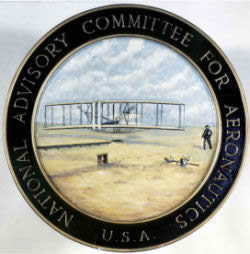
On October 1, 1958 the agency was dissolved, and its assets and personnel transferred to the newly created National Aeronautics and Space Administration -
NASA.
The act of Congress creating NACA, approved March 3, 1915, reads, "...It shall be the duty of the advisory committee for aeronautics to supervise and direct the scientific study of the problems of flight with a view to their practical solution...."
In 1922, NACA had 100 employees. By 1938, it had 426. In addition to formal assignments, staff was encouraged to pursue unauthorized "bootleg" research, provided that it was not too exotic. The result was a long string of fundamental breakthroughs, including "NACA engine cowl" (1930s), the "NACA airfoil" series (1940s), and the "Area rule" for supersonic aircraft (1950s).
The name NACA remains familiar in the automotive world for the NACA duct, a type of air intake, or to those in the aircraft industry, as several series of NACA airfoil and NACA cowling are still being used in new design.

If you think drag is a bad thing for a race car, talk to an aeronautical engineer. Every bit of drag on an airplane, rocket or car creases the amount of fuel needed to stay in flight and limits the maximum speed achievable. That's makes minimizing drag critical. The NACA duct brings air into a vehicle with minimal increase in drag. The NACA duct or NACA scoop is a common form of low-drag intake design, and when properly implemented, it allows fluid to be drawn into an internal duct, often for cooling purposes, with a minimal disturbance to the flow. The design was originally called a "submerged inlet," since it consists of a shallow ramp with curved walls recessed into the exposed surface of a streamlined body, such as an aircraft. It is especially favoured in racing car design.

The purpose of a NACA duct is to increase the flow rate of air through it while not disturbing the boundary layer. When the cross-sectional flow area of the duct is increased, you decrease the static pressure and make the duct into a vacuum cleaner, but without the drag effects of a plain scoop. The reason why the duct is narrow, then suddenly widens in a graceful arc is to increase the cross-sectional area slowly so that airflow does separate and cause turbulence (and drag).
NACA ducts are useful when air needs to be drawn into an area which isn't exposed to the direct air flow the scoop has access to. Quite often you will see NACA ducts along the sides of a car or engine bonnet. The NACA duct takes advantage of the boundary layer, a layer of slow moving air that "clings" to the bodywork of the car, especially where the bodywork flattens, or does not accelerate or decelerate the air flow. Areas like the roof and side body panels are good examples. The longer the roof or body panels, the thicker the boundary layer becomes (a source of drag that grows as the layer thickens too).
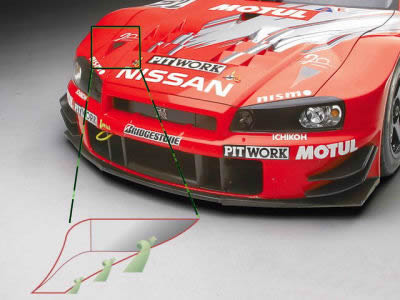
This design is believed to work because the combination of the gentle ramp angle and the curvature profile of the walls creates counter-rotating vortices which deflect the boundary layer away from the intake and draws in the faster moving air, while avoiding the form drag and flow separation that can occur with protruding inlet designs. This type of flush inlet generally cannot achieve the larger ram pressures. However it is common for engine and ventilation intakes.
The original goal of the NACA duct was not applications requiring maximum pressure recovery (ram pressure), unlike the prominent ram-type intakes seen behind the driver's head in Formula One cars. The application was intended for applications where is desired to minimize the parasite drag added to the aircraft or car. This works well for air vents and such as the drag remains low whether the vent is opened or closed. It is not very useful for engine air intakes, bur is useful for cooling air supply. They are low-drag intake channels used mostly for a variety of cooling requirements such as brakes, engine, and for driver cooling intake. Distinctive geometry includes a widening mouth at the inlet, with the duct floor slightly opening up the flow area.
Sometime, to increase air supply, constructors can use a small scoop as on the picture of Bentley LMP car below. Extensive wind tunnel testing of various designs has resulted in the best compromise of flow rate to drag. In the case of this GT car, the NACA duct on the hood feeds small airboxes that direct cool air into the front brakes. Sharp wall-edges effectively generate vortices that help keep the flow attached to the diffuser-like slope floor. These edges have to be sharp (unlike many aftermarket parts copies), otherwise the flow would separate, reducing the duct's efficiency.
 |
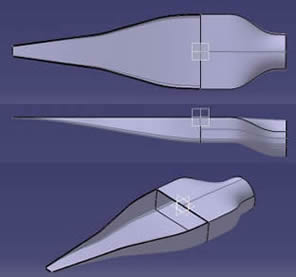 |
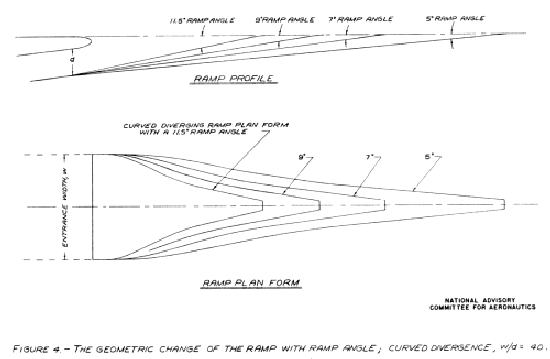
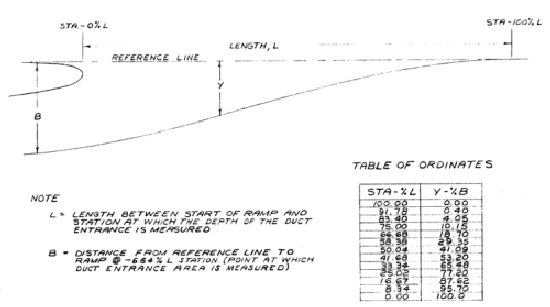

A few words on implementing your own NACA duct as a means of induction to your race car.
-1: design is very important. The duct is designed to be efficient with the correct wall angles (sharp), base slope, and width-to-depth ratio in relation with speed.
-2: The duct needs to be installed in an area of high pressure. A leading edge of a car is a great place.
-3: Don't buy garbage. Edges on the slopes have to be sharp, otherwise the flow would separate, reducing the duct's efficiency.
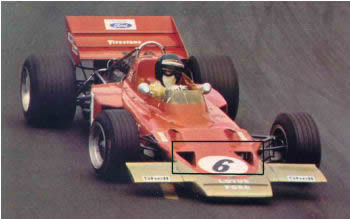 -4: NACA duct is only useful in applications where you really don't want much air, at least not as much as you hoped, and certainly less than you expect.
-4: NACA duct is only useful in applications where you really don't want much air, at least not as much as you hoped, and certainly less than you expect.
-5: If you want any air at all, make sure the NACA duct is placed in a region with a positive pressure gradient; i.e., put it where the air sees the body as increasing in size, not constant or decreasing.
-6: They don't work well, or at all, when placed on the negative pressure area.






